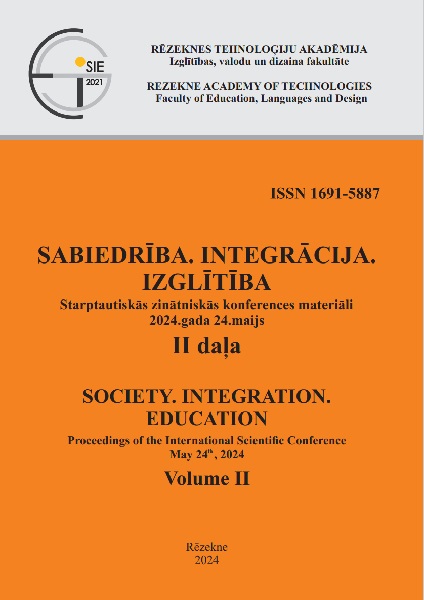EXPLORING THE CONSISTENCY BETWEEN TEACHERS' AND PARENTS' RATINGS OF CHILDREN'S LANGUAGE SKILLS
DOI:
https://doi.org/10.17770/sie2024vol2.7856Keywords:
BAASIK, children, expressive language, parents, receptive language, screening, teachersAbstract
Aim: The study investigated the correspondence between parent and teacher assessments of 3 to 6-year-old children's language skills using the Expressive and Receptive Language Scales from the Early Childhood Developmental Screening Toolkit – BAASIK (an acronym in Latvian).
Material and methods: Ninety-five preschool teachers and 424 parents participated in an online survey assessing the expressive and receptive language skills of children aged 3 to 6 years.
Results: Spearman's correlation analysis revealed statistically significant (p < .001) moderate to strong correlations between the ratings of children’s language skills by parents and teachers. For the Receptive Language Scales, correlations ranged from rS = .43 to rS = .6, and for the Expressive Language Scales, from rS = .54 to rS = .64.
Conclusions: The study confirmed that parents’ and teachers’ assessments of children’s expressive and receptive language skills are significantly correlated. The BAASIK Expressive and Receptive Language Scales used by both parents and teachers could be effective for early screening, potentially aiding in the prompt identification of language development issues and the subsequent referral to speech and language therapy services.
References
Bishop, D. V., & Baird, G. (2001). Parent and teacher report of pragmatic aspects of communication: Use of the children's communication checklist in a clinical setting. Developmental Medicine and Child Neurology, 43(12), 809-818.
Bishop, D. V. M., & McDonald, D. (2009). Identifying language impairment in children: Combining language test scores with parental report. International Journal of Language & Communication Disorders, 44(5), 600–615.
Bishop, D. V. M., Snowling, M. J., Thompson, P. A., Greenhalgh, T., & CATALISE consortium. (2016). CATALISE: A multinational and multidisciplinary Delphi consensus study. Identifying language impairments in children. PLoS ONE, 11(7), e0158753.
Bishop, D. V. M., Snowling, M. J., Thompson, P. A., & Greenhalgh, T. (2017). Phase 2 of CATALISE: A multinational and multidisciplinary Delphi consensus study of problems with language development: Terminology. Journal of Child Psychology and Psychiatry, 58(10), 1068-1080.
Cabell, S. Q., Justice, L. M., Zucker, T. A., & Kilday, C. R. (2009). Validity of Teacher Report for Assessing the Emergent Literacy Skills of At-Risk Preschoolers. Language Speech and Hearing Services in Schools, 40(2), 161-173.
Chung, C.-Y., Liu, W.-Y., Chang, C.-J., Chen, C.-L., Tang, S. F.-T., & Wong, A. M.-K. (2010). The Relationship Between Parental Concerns and Final Diagnosis in Children With Developmental Delay. Journal of Child Neurology, 26(4), 413–419.
Hauerwas, L. B., & Stone, C. A. (2000). Are parents of school-age children with specific language impairments accurate estimators of their child's language skills? Child Language Teaching and Therapy, 16(1), 73–86.
Hendricks, A. E., Adlof, S. M., Alonzo, C. N., Fox, A. B., & Hogan, T. P. (2019). Identifying Children at Risk for Developmental Language Disorder Using a Brief, Whole-Classroom Screen. Journal of Speech, Language, and Hearing Research, 62(4), 896–908. https://doi.org/10.1044/2018_JSLHR-L-18-0093
Kiing, J. S. H., Neihart, M., & Chan, Y. (2019). Teachers' role in identifying young children at risk for developmental delay and disabilities: Usefulness of the Parents Evaluation of Developmental Status tool. Child Care, Health and Development, 45(5), 637-643.
Massa, J., Gomes, H., Tartter, V., Wolfson, V., & Halperin, J. M. (2008). Concordance rates between parent and teacher clinical evaluation of language fundamentals observational rating scale. International Journal of Language & Communication Disorders, 43(1), 99–110.
McLeod, S., Crowe, K., McCormack, J., White, P., Wren, Y., Baker, E., ... Roulstone, S. (2017). Preschool children's communication, motor and social development: Parents' and educators' concerns. International Journal of Speech-Language Pathology, 20(4), 468–482.
McLeod, S., & Harrison, L. J. (2009). Epidemiology of Speech and Language Impairment in a Nationally Representative Sample of 4- to 5-Year-Old Children. Journal of Speech, Language, and Hearing Research, 52(5), 1213–1229.
Paul, R. (2007). Language disorders from infancy through adolescence (3rd ed.). Mosby Elsevier.
Pring, T. (2005). Research methods in communication disorders. Whurr Publishers Ltd.
Raščevska, M., Nīmante, D., I. Umbraško, I. Bite, Trinīte, B., Tomele, G., Helmane, S., Grope, I., Vabale, A., Bezborodovs, Ņ. Laganovska, E. (2024). Psiholoģiskās novērtēšanas skrīninga instrumentu komplekta izstrāde bērnu agrīnās attīstības risku atpazīšanai. I daļa. Skrīninga konstruktu teorētiskais pamatojums un attīstības veicināšanas intervenču pieejamība. Rīga: LU Akadēmiskais apgāds.
Sansavini, A., Favilla, M. E., Guasti, M. T., Marini, A., Millepiedi, S., Di Martino, M. V., ... Lorusso, M. L. (2021). Developmental Language Disorder: Early Predictors, Age for the Diagnosis, and Diagnostic Tools. A Scoping Review. Brain Sciences, 11(5), 654.
Sattler, J. M. (1992). Assessment of children (3rd ed.). San Diego: Jerome M. Sattler, Publisher, Inc.
Urek, O., Vulane, A., Dargis, R., Taurina, A., Zirina, T., & Simonsen, H. G. (2019). Latvian CDI: methodology, developmental trends, and cross-linguistic comparison. Journal of Baltic Studies, 50(3), 285-305.
Vulane, A., Taurina, A., Zirina, T. (2016). Survey as an evaluation technique of the development of child's vocabulary. In D. Markus, A. Vulane (Eds.) Child Language in 21st century Latvia II (21-43). Rīga: RaKa.
World Health Organization [WHO]. (2018). International Classification of Diseases for Mortality and Morbidity Statistics (11th ed.). World Health Organization.






